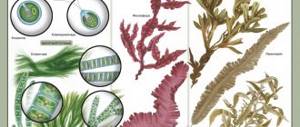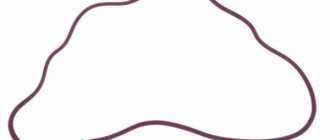Summary of a biology lesson on the topic “Algae” (grade 7)
Lesson No. 12 on the topic: “Algae”
Target
: to introduce students to the characteristic features of the structure and vital activity of algae as representatives of lower plants, distinguishing them from bacteria, fungi, and lichens.
Educational objectives:
- find out the features of the external structure of algae;
- show the features of the cellular structure of algae;
- give an idea of the systematics of algae;
- develop the ability to conduct scientific dialogue;
- improve skills in working with scientific text, drawings, herbarium, and laboratory material.
Educational tasks:
- fostering curiosity;
- fostering respect for nature.
Developmental tasks:
- development of subject-speech skills;
Equipment
: tables, herbarium, text and pictures of the textbook, textbook “Biology. Diversity of living organisms.”
Terms and concepts of the lesson:
thallus, thallus, autotrophic nutrition.
Lesson type
: laboratory
Lesson plan:
- Organizational moment (1 min).
- D/Z check (10 min.)
- Updating basic knowledge and motivating learning activities, setting and solving cognitive problems (15 min.)
- Updating the topic - a conversation about algae.
- Algae sizes
- The structure of algae.
- Habitat
- Algae feeding.
Cellular structure of algae
IV. Laboratory work (10 min.)
V. Consolidation: compiling a general description of algae (6 min.)
VI. D/Z
DURING THE CLASSES
1.Organizational stage:
I check the students’ overall readiness for the lesson and note those who are absent.
2.D/Z check
page 61 method manual
3
.
Updating basic knowledge.
Conversation with students.
What associations do you have when you hear the word algae? Today in the lesson we will get acquainted with a group of plants whose body does not have plant organs known to you - leaves, stems, roots, etc. - with algae.
Announcement of the topic of the lesson
Announcement of the goal: the goal of our lesson today will be to get acquainted with the general characteristics of algae, the structural features of their cells and body, habitat and their classification.
3. Studying new material.
- General characteristics of algae.
Teacher's story.
Algae, the oldest group of plant organisms whose body is not divided into organs, is called thallus
or
thallus.
More than 20 thousand species are known.
of algology studies algae.
Algae size.
Algal habitats
- the bulk of algae lives in the aquatic environment, but algae are also found in the soil, air, on snow, on tree trunks, in animal fur (sloth), in the body of other organisms as symbiotics - zooxanthellae in the body of lichen).
In the aquatic environment, they can be part of plankton or grow at the bottom of reservoirs, being benthic organisms.
The structure of the thallus.
The body of algae is represented by a thallus
and does not have real tissues, and therefore organs - leaves, stems, roots. The body of some charophyte algae resembles that of land plants, with leaves and a stem, but in fact they are the branches of a thallus.
In shape, the multicellular thallus can be filamentous, heterofilamentous, linearly segmented (characeous), lamellar (ulva, ulothrix).
In algae living at the bottom of reservoirs, the body is attached to the substrate by rhizoids or a lamellar disk.
The structure of an algae cell.
The cells' structure resembles that of land plants. The top is covered with a cell membrane rich in cellulose and pectin. The center of the cell is the nucleus. Algae contain chlorophyll, contained in chromatophores of various structures - pear-shaped, spiral-shaped (spirogyra), etc. In addition to chlorophyll, a green pigment, algae cells may contain red and yellow pigments. The chromatophore may contain a pyrenoid - a body with reserve nutrients - mainly carbohydrates. There are also vacuoles and cytoplasm.
By type of nutrition, algae are autotrophs, as they are capable of photosynthesis.
- Systematics of algae.
Teacher's story.
Subkingdom of algae (Phycobionta)
Department Green algae (Chlorophyta) Department Charophyta (Charophyta) Department Euglenophyta (Euglenophyta) Department Golden algae (Chrysophyta) Department Yellow-green algae (Xanthophyta) Department Diatoms (Bacillariophyta) Department Dinophyte algae (Dino) phyta ) Department Cryptophyta algae Department Brown algae (Phaeophyta)
5.Lab work
6. Consolidation and systematization of knowledge.
7. Lesson summary and homework
Lesson 36. Algae. General characteristics of algae
Methodological guide for developing biology lessons 6th grade
Lesson type -
combined
Methods:
partially search, problem presentation, reproductive, explanatory and illustrative.
Target:
- students’ awareness of the significance of all the issues discussed, the ability to build their relationships with nature and society on the basis of respect for life, for all living things as a unique and invaluable part of the biosphere;
Tasks:
Educational
: show the multiplicity of factors acting on organisms in nature, the relativity of the concept of “harmful and beneficial factors”, the diversity of life on planet Earth and options for adaptation of living beings to the entire range of environmental conditions.
Educational:
develop communication skills, the ability to independently obtain knowledge and stimulate one’s cognitive activity; ability to analyze information, highlight the main thing in the material being studied.
Educational:
Formation of an environmental culture based on recognition of the value of life in all its manifestations and the need for a responsible, careful attitude towards the environment.
Forming an understanding of the value of a healthy and safe lifestyle
UUD
Personal
:
nurturing Russian civic identity: patriotism, love and respect for the Fatherland, a sense of pride in one’s Motherland;
Formation of a responsible attitude towards learning;
3) Formation of a holistic worldview that corresponds to the modern level of development of science and social practice.
Cognitive
: ability to work with various sources of information, convert it from one form to another, compare and analyze information, draw conclusions, prepare messages and presentations.
Regulatory:
the ability to organize independent completion of tasks, evaluate the correctness of work, and reflect on one’s activities.
Communicative:
Formation of communicative competence in communication and cooperation with peers, seniors and juniors in the process of educational, socially useful, educational and research, creative and other types of activities.
Planned results
Subject:
know the concepts of “habitat”, “ecology”, “ecological factors”, their influence on living organisms, “connections between living and non-living things”;. Be able to define the concept of “biotic factors”; characterize biotic factors, give examples.
Personal:
express judgments, search and select information; analyze connections, compare, find an answer to a problematic question
Metasubject
:.
The ability to independently plan ways to achieve goals, including alternative ones, to consciously choose the most effective ways to solve educational and cognitive problems.
Formation of semantic reading skills.
Form of organization of educational activities –
individual, group
Teaching methods:
visual-illustrative, explanatory-illustrative, partially search-based, independent work with additional literature and a textbook, with COR.
Techniques:
analysis, synthesis, inference, translation of information from one type to another, generalization.
Objectives: introduce a group of plants called algae; give an idea of algae as the most ancient representatives of plants; introduce the habitat of algae, reveal the structural features of the body of unicellular green algae as the most simply organized representatives of the plant world, give an idea of the methods of their reproduction; continue the formation of knowledge about higher and lower plants; develop the ability to work with a microscope and the skill of performing biological drawings.
Equipment and materials: table “Single-celled algae”, pieces of tree bark with a coating of unicellular algae, a pot with a houseplant on the surface of the soil of which unicellular algae live, herbariums of various multicellular algae, live algae from an aquarium.
Key words and concepts: algae, green algae department, brown algae department, red algae department; lower plants, thallus (thallus), unicellular algae, multicellular algae; water bloom, chlamydomonas, chlorella; flagella, membrane, cytoplasm, nucleus, light-sensitive body (eye), pulsating vacuoles, chromatophore; positive phototaxis; sexual and asexual reproduction, gametes, zygote, zoospore.
During the classes
I. Updating knowledge
Answer the questions.
What is taxonomy?
What are the main achievements of Carl Linnaeus?
Which of the following plants belong to the same genus: rosea radiola, downy birch, greater plantain, caustic ranunculus, warty birch, lanceolate plantain, golden ranunculus?
What is a species?
.What is a variety?
What systematic group includes several genera similar in structure and origin?
7..Give examples of double plant names.
8. In what cases can the name of a plant consist of more than two words?
Learning new material
Teacher's story with elements of conversation
Today we begin the study of algae. Algae are a large group of plants that includes several divisions. We will get acquainted with representatives of only three departments: green algae, brown algae
and
red algae
.
You've probably seen algae many times. Where do they live? (Most often in water.)
In what waters can algae live? (Students' answers.)
Algae live in both fresh and salt waters
. They can live in standing water (ponds, lakes) and running water (rivers).
Where else are algae found? (Students' answers.)
Algae can also live on moist soil, on bark
trees growing in damp places
.
The teacher demonstrates algae in an aquarium, on the bark of a tree, on the surface of the soil in a pot with a houseplant.)
You are probably familiar with the theory that life originated in water. Algae are one of the most ancient
plants. Due to this, they have the simplest structure. But, despite this, different groups of algae have different ancestors, and therefore are quite different from each other.
Remember which plants - higher or lower - algae belong to. (Algae are lower plants.)
What is the fundamental difference between higher plants and lower ones?
Lower plants do not have differentiated organs - roots, stems, leaves, etc. The body of algae (even the largest) is not divided into separate organs that perform specific functions. They do not have separate photosynthetic or absorptive organs. Algae perform these functions over the entire surface of the body. The body of algae, not differentiated into organs, is called thallus, or thallus.
Why do you think algae don't have organs? (Students' answers.)
Since algae live in water or in a humid environment, they can absorb various substances over the entire surface and, accordingly, photosynthesize.
Among the algae there are both microscopic single-celled organisms and real giants, reaching several tens of meters in length.
We will begin our study with unicellular green algae.
You've probably observed water blooms
in small bodies of water.
The water acquires a greenish-emerald hue due to the large number of unicellular algae that have multiplied there in favorable conditions. Chlamydomonas
or
are most often found in blooming water .
Chlamydomonas (translated from Greek as “the simplest organism covered with clothing”) has a pear-shaped body; at the anterior, narrower end of the body there are two flagella
, with the help of which the algae can move.
The body of the plant is covered with a transparent membrane,
under which there is
a cytoplasm
with a nucleus located in it
,
a red
light-sensitive body
(eye), a large
vacuole
filled with
cell sap,
and two small
pulsating vacuoles,
which serve the algae to release excess water and unnecessary substances.
Most of the cell space is occupied by a chromatophore
containing the pigment chlorophyll, as well as other pigments.
Why is algae green? (Students' answers.)
The green color of algae is given by the chlorophyll pigment contained in the chromatophore.
What does the presence of chlorophyll in algae indicate? (Students' answers.)
This indicates the ability of Chlamydomonas to photosynthesize,
i.e., the formation of organic substances from inorganic substances (carbon dioxide and water).
What do you think is the advantage of free-floating algae? (Students' answers.)
A plant capable of free movement can independently choose the most favorable place.
What do you think would be the most suitable conditions for photosynthetic green algae? (Students' answers.)
The best option for it is the presence of bright sunlight. If you constantly illuminate a container of water in which chlamydomonas live, on the one hand, then after a while you will notice that clusters of these plants have appeared there. The photosensitive eye of the algae perceives light, and with the help of flagella it moves towards a more illuminated place. This desire for light is called positive phototaxis.
But Chlamydomonas is capable of not only feeding on the products of photosynthesis, but also absorbing ready-made organic substances over the entire surface of the body.
Chlorella is spherical
form. The cell body is also covered with a membrane, under which there is cytoplasm with a nucleus and a large chromatophore.
Consolidation of knowledge and skills
Answer the questions.
What unicellular green algae do you know? Give examples.
In what environments do algae live?
What is the structure of the single-celled green alga Chlamydomonas?
What is the body of algae called?
Explain why algae do not have organ differentiation.
What is the function of a chromatophore?
What is the significance of the photosensitive eye?
What common features and differences can be seen in the structure of Chlamydomonas and Chlorella?
How can Chlorella reproduce?
In what ways can Chlamydomonas reproduce?
Summing up the lesson
Homework
Read the paragraph, know the basic terms, answer the questions orally at the end of the paragraph. (Textbook by I.N. Ponomareva § 38; textbook by V.V. Pasechnik § 12.)
Creative task.
Make a three-dimensional model of single-celled green algae Chlamydomonas and Chlorella from colored plasticine. The model can also be made from salt dough. To do this, take wheat flour and salt in equal proportions, add water and knead into a thick dough. Make a model, put it in the oven over low heat and keep it until it hardens. Remove and cool the product. Color it with paints. Finally, you can coat the model with varnish.
An activity for students interested in biology.
Ask your teacher for a small amount of a culture of the unicellular alga Chlamydomonas. Place the algae in a jar with a nutrient solution and cover it with a piece of glass. After some time, a green coating forms on the wall of the transparent container facing the light. This is a cluster of single-celled green algae Chlamydomonas. You need to monitor the progress of the experiment. Record data on changes in the color and composition of water in a special notebook.
Seaweed .
Educational film
Algae
Biology | Preparation for the Unified State Exam 2020 | Lower plants Algae
Biology 6 Lower plants algae
Resources:
I.N.
Ponomareva, O.A.
Kornilova, V.S. Kuchmenko Biology: 6th grade: textbook for students of general education institutions
Serebryakova T.I.
., Elenevsky A. G., Gulenkova M. A. et al. Biology. Plants, Bacteria, Fungi, Lichens. Trial textbook for grades 6-7 of secondary school
N.V. Preobrazhenskaya
Biology workbook for the textbook by V. Pasechnik “Biology 6th grade. Bacteria, fungi, plants"
V.V. Pasechnik
. Manual for teachers of general education institutions Biology lessons. 5-6 grades
Kalinina A.A.
Lesson developments in biology grade 6
Vakhrushev A.A., Rodygina O.A.,
Lovyagin S.N. Verification and control work for
textbook "Biology", 6th grade
Biolessons
https://biouroki.ru/material/lab/2.html
YouTube website
: https://www.youtube.com/
Presentation hosting
— https://ppt4web.ru/nachalnaja-shkola/prezentacija-k-uroku-okruzhajushhego-mira-vo-klasse-chto-takoe-ehkonomika.html






